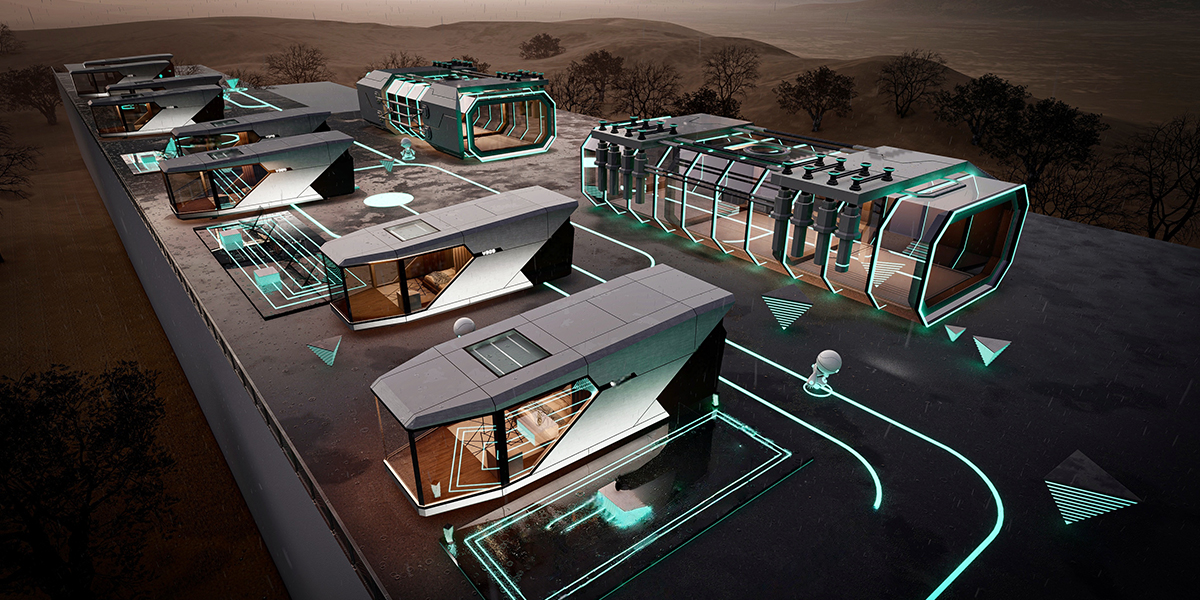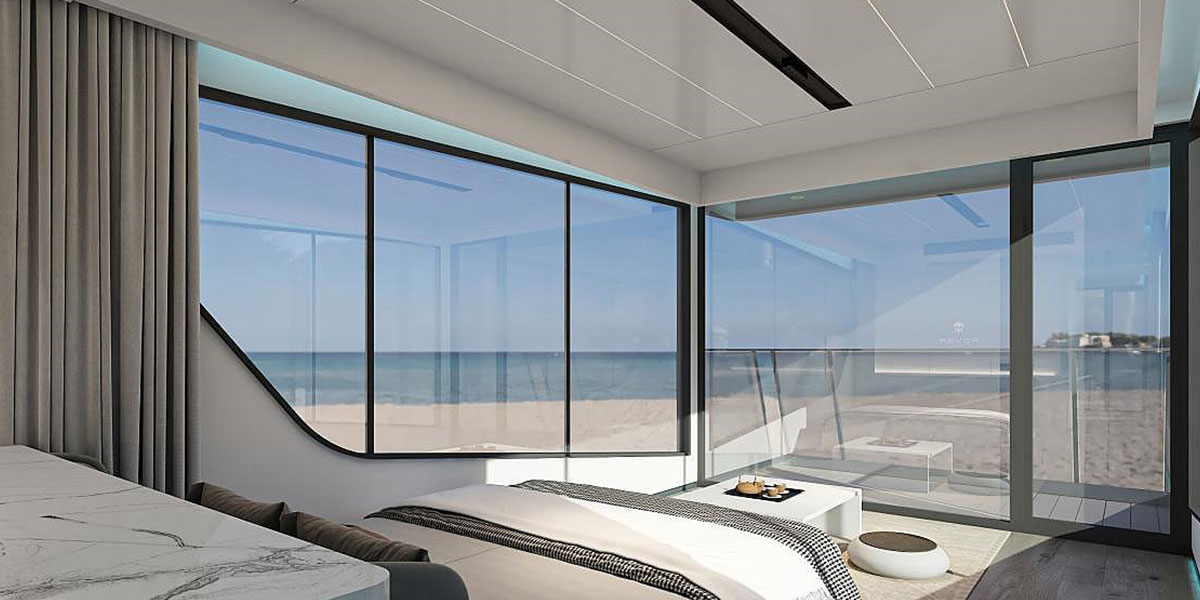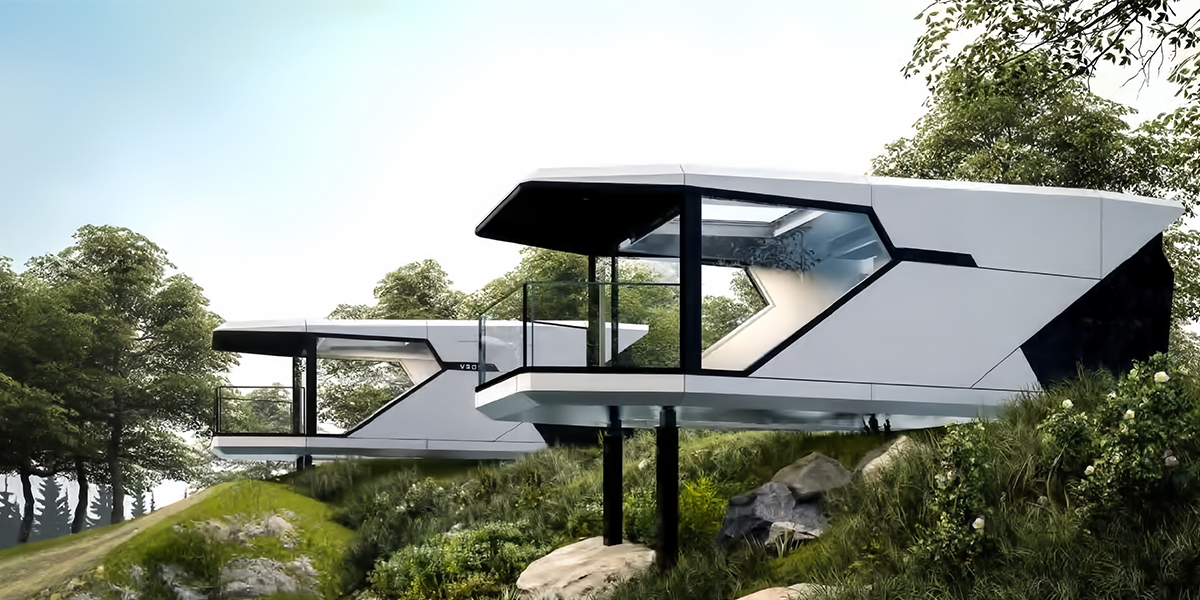
16 Jul Everything You Need to Know About Capsule Houses
Table of Contents
A capsule house gives you a small and useful place to live. Many capsule models use strong materials like galvanized steel or aluminum. This kind of home is often made in a factory. You can set it up fast and move it easily. Many people pick a capsule house because it costs less and is good for the environment. You might see a capsule used as an office, shop, or even a place to eat. The simple look and small size make a capsule great for people who want cheap and flexible homes.
Key Takeaways
Capsule houses are tiny, low-cost homes that use space well with folding furniture and parts you can move. They help you save money because they are cheaper to build, use less energy, and need less fixing. These homes use tough, earth-friendly materials and often have smart things like solar power and remote controls. Capsule houses let you change or move your space, so they are good for students, travelers, and young workers. Living in a capsule house means you get less privacy and room, so you should look at local rules and plan well before you buy one.
Capsule House Basics
What Is a Capsule House
A capsule house gives you a small place to live. It has what you need, like a bed and storage. Sometimes, there is a tiny workspace too. The modular design lets you add or take away parts. This helps you save space and money. Many capsule homes have furniture that saves space. Beds can fold up, and tables can be used as desks. Built-in features help keep things neat and tidy. Capsule houses help people live simply and use space well. You can find them in cities, for travel, or in the countryside.
Tip: Capsule houses often have shared kitchens and bathrooms. You get your own private space but use shared areas for daily needs.
Here are the main features of capsule homes:
- Small units with only the basics.
- Shared kitchens and bathrooms to save space.
- Furniture that can be used in different ways.
- Smart technology for comfort and saving energy.
- Eco-friendly materials and energy-saving designs.
- Good for cities, short stays, or emergencies.
- Modular parts make changes and upgrades easy.
How Capsule Houses Work
 You use every bit of space in a capsule house. The modular design lets you move or grow your home. Most capsule homes are made in a factory. You can set up your capsule fast, sometimes in days. You can move your capsule if you need to. Many people use capsules as offices, guest rooms, or small hotels.
You use every bit of space in a capsule house. The modular design lets you move or grow your home. Most capsule homes are made in a factory. You can set up your capsule fast, sometimes in days. You can move your capsule if you need to. Many people use capsules as offices, guest rooms, or small hotels.
Capsule homes use smart technology to help you. You can control lights, heat, and security with your phone or voice. Some capsules use solar panels or wind turbines for power. This saves money and helps the planet. Being easy to move makes capsule homes popular with students, young workers, and travelers.
Capsule homes are more popular now. The table below shows how the market has grown:
Statistic Description | Value / Detail |
|---|---|
Global market size (2024) | |
Projected market size (2030) | USD 432.5 million |
CAGR (2025-2030) | 8.8% |
Generation Y travelers (age 21-34) | |
Revenue generated by Generation Y | USD 180 million |
Growth in Generation Y segment since 2007 | Nearly 30% increase |
Asia-Pacific market share (2024) | About 58% |
Solo travelers market share | About 71% |
Age group 18-24 market share (2024) | About 41% |
Online booking CAGR (2025-2030) | 9.2% |
Demand growth for age group 25-39 (2025-2030) | CAGR of 9.2% |
Young people and solo travelers want capsule homes the most. The Asia-Pacific area leads the market, but more people everywhere are interested.
History and Evolution
Capsule houses started in Japan in the 1960s and 1970s. Architects wanted to fix problems in crowded cities with high housing costs. The Nakagin Capsule Tower in Tokyo was built in 1972 by Kisho Kurokawa. It became famous for its modular capsules that could be moved or replaced. The goal was to make homes that were flexible and cheap for city life.
Capsule homes have changed and gotten better over time. Early capsule homes were mostly for short stays, like capsule hotels. Now, you can find capsules with smart home systems and eco-friendly features. Modern capsule houses use new modular building methods and smart technology. You can find capsule homes in many countries for both short and long stays.
The table below shows how different places and groups helped capsule homes grow:
Region | Demographic and Market Drivers |
|---|---|
Asia-Pacific | Cities in Japan and China have lots of people. High property prices and fast city growth help the market. Technology is used a lot. |
Middle East & Africa | More people live in cities, and real estate costs are high. Cities like Dubai and Johannesburg are seeing more interest. The market is still new but growing. |
People in cities like simple and green living. Governments help with money and city projects. Scandinavian countries use capsule homes in city plans. | |
Australia | People face high housing costs. Students want cheap, green homes. Some areas need strong homes for disasters. |
United States | Millennials and Gen Z want affordable homes. Essential workers cannot afford regular houses. Tech lovers like smart home features. New housing rules help too. |
Capsule homes now help many people, like students, workers, travelers, and families. People pick capsule houses because they are cheap, easy to move, and look modern.
Capsule Homes Features
 Materials and Build
Materials and Build
Capsule homes use strong and safe materials. Builders pick galvanized steel, aluminum, and insulated panels. These keep the capsule light but sturdy. They also protect you from fire, water, and bad weather. Experts test these materials in many ways to make sure they last a long time.
Test Type | Validation Outcome |
|---|---|
Accelerated Aging Tests | Show they can handle heat and moisture for years. |
Environmental Simulations | Prove they stay strong in hot and wet weather. |
Long-Term Field Monitoring | Show they work well in wet places for a long time. |
Structural Stability & Aging | Prove they do not crack or bend as they get older. |
You get a safe home because of careful checks and smart design. Engineers use special tools to check if your capsule is safe. Builders write down every step and material, so you know your home is built right.
Size and Layout
Most capsule homes are between 100 and 500 square feet. The space is small but feels bigger because of smart design. Designers use beds that fold up and tables that do more than one job. Big windows and bright lights make the space feel open.
Evidence Type | Details |
|---|---|
Size Range | |
Space Efficiency | Foldable and multi-use furniture saves space |
Modularity | Modular parts make setup fast and moving easy |
Urban Space Solution | Works well in busy cities where space is expensive |
Amenities Included | Many have kitchens, bathrooms, and modern features |
Environmental Features | Water-saving systems help use less water |
Demographic Preference | People in cities and young adults like small, easy homes |
You can pick a capsule that fits what you want. You can have one unit or connect more together. This makes capsule homes very flexible and special.
Eco-Friendly Technology
Capsule homes use green technology to save energy and help the planet. Builders use recycled steel and good insulation. You get smart thermostats and LED lights to save power. Many capsules use solar panels or other clean energy. The modular design means less waste and easy upgrades.
Modern capsule homes are made to use less energy. Good insulation and smart controls help you save on heating and cooling. These homes help cities grow in a way that uses fewer resources and makes less trash.
Note: Most capsule homes focus on safety and quality, even though they use many green features.
Affordable Living Benefits
 Cost Savings
Cost Savings
Choosing a capsule house helps you save money. These homes are built in factories, so they cost less to make. Builders spend less time and money putting them together. Simple models start at about $10,000. Fancier ones can cost $50,000 or more. Capsule houses are cheaper than most regular homes. You also pay less for heating, cooling, and fixing things. The space is small, and the materials are strong.
Aspect | Economic Advantage / Cost Benefit Description |
|---|---|
Construction Cost | Capsule houses cost about $20,000 to $100,000. This is usually less than regular homes. |
Utility Savings | Energy-saving designs mean lower bills for heating and cooling. You spend less on utilities. |
Maintenance | Small size and tough materials mean you fix things less often. This saves you time and money. |
Installation | You can set up a capsule house in as little as 3 days. This means you pay less for workers and move in faster. |
Sustainability | Using fewer resources and making less waste is good for your wallet and the planet. |
Capsule houses help you save money over time too. Smart technology and energy-saving systems lower your bills. The strong materials last a long time, so you fix things less. Many people like capsule homes because they are comfy and not expensive.
Sustainability
Capsule houses are good for the planet. Builders use recycled materials and energy-saving systems. This means less waste and less pollution. Making them in a factory uses fewer materials than building on-site. Good insulation and smart controls help you use less energy.
- Living in a tiny home like a capsule house can cut your impact on the earth by about 45%.
- People in these homes use less energy, eat more local food, and recycle more.
- These choices help the planet and make cities greener.
When you pick a capsule house, you help the environment. Studies show these homes use fewer resources and make less pollution over time. You can feel proud that your home is both cheap and green.
Flexibility
Capsule houses let you change your space when you need to. You can add or take away parts, move walls, or use foldable furniture. This helps you use every bit of space. Many capsule homes have smart technology. You can control lights, heat, and security with your phone.
- Sliding walls and foldable furniture help you change your space.
- You can make your home bigger or smaller with modular parts.
- Smart home features make your home easy to adjust.
Examples like the Elysium Capsule and Orion Capsule show how flexible these homes are. You can use them for work, school, or family life. Capsule homes help you live well when things change. They are a smart pick for people who want a cheap and flexible home.
Tip: Capsule houses are great for young workers, students, or anyone who wants a home that is both cheap and easy to change.
Drawbacks and Challenges
Space Limitations
Living in a capsule house means you have less space than in a regular home. You might find it hard to store all your things or move around freely. Many capsule houses use smart designs, but the small size can still feel tight. Reports about famous capsule buildings, like the Nakagin Capsule Tower in Tokyo, show that space is a real challenge. The original idea was to let you change or replace each capsule easily. In practice, the design made it hard to swap out a single unit without major work. Fixed plumbing and other services also limit how you can use the space. These technical and comfort issues make it tough to adapt the inside of your capsule house.
Note: You may need to get creative with storage and daily routines to make the most of your space.
Privacy Concerns
Privacy can be another challenge in capsule houses. Thin walls and close neighbors mean you might hear sounds from other units. Shared kitchens and bathrooms are common, so you do not always have your own private space. If you value quiet or alone time, you may find this setup difficult. You might need to use headphones or set up a small divider for more privacy. Some people enjoy the social side of shared spaces, but others may feel uncomfortable.
- You share many areas with others.
- Noise can travel easily between capsules.
- Personal space is limited.
Legal and Zoning Issues
Capsule houses face many legal and zoning hurdles. Rules about where you can build and what type of home you can have change from place to place. Zoning laws decide if you can put a capsule house in a certain area. Many cities do not allow small homes in regular neighborhoods. You may have better luck in mixed-use zones, but you still need to check the rules.
- Zoning laws control land use and building types.
- Capsule houses often do not fit standard home rules.
- You must research local laws before you buy or build.
- Getting permits takes time and paperwork.
- You may need special permission or help from experts.
Some places welcome capsule houses, but others have strict rules or bans. Always talk to local officials and legal experts before you start. This helps you avoid problems and makes sure your capsule house is legal.
Capsule House for Sale and Setup
Price Range
When you shop for a capsule house, prices can be very different. The price depends on the size, what it is made of, and what features it has. Most capsule houses cost at least $20,000. Some cost over $100,000 if you want fancy finishes or smart tech. Regular homes usually cost more than $200,000. Modular and prefabricated homes are cheaper but have fewer custom choices. The table below shows how these homes compare:
Factor/Aspect | Capsule Houses | Traditional Homes | Modular Homes | Prefabricated Homes |
|---|---|---|---|---|
Price Range | $200,000+ | Lower than capsule | Most affordable | |
Customization | High | Varies | Moderate | Limited |
Construction Time | Weeks | Months–Years | Shorter | Quick |
Capsule house ads often talk about green materials and smart features. These things can make the price higher, but they also make your home nicer and save energy.
Buying Process
You need to do a few things to buy a capsule house:
- Check the rules for building in your area.
- Get the right permits before you start.
- Make sure your land is flat and ready.
- Set up water, gas, and power.
- Hire someone to help with building and setup.
- Plan for inspections from the city.
Capsule house companies can help you with each step. You should also plan for land, permits, insurance, and setup costs. Many people pick capsule houses because buying one is simple and not too expensive.
Installation Steps
After you buy your capsule house, you must get your land ready. First, clear the land and make it flat. Then, connect water and power and put down a base if needed. The company brings your capsule house and puts it in place. Most setups only take a few days. You need to pass inspections before you can move in. Capsule house companies often help with setup.
Tip: Off-grid power and water can cost more at first but may save money later.
Maintenance Tips
Capsule houses are easier to care for than regular homes. Check the base, roof, and outside for damage each season. Look at plumbing, wires, and heating or cooling often. Clean windows and doors so they work well. Keep bugs away and clean up around your home. If you use good materials, you will fix things less. Capsule house companies may give you guides to help you care for your home.
Taking care of your capsule house helps it last longer and saves you money.
A capsule house is a smart and cheap way to live. It works well in busy cities or if you want to save money. You get things like low price, green design, and space you can change. But you might have less privacy and not much room. Capsule homes are best for students, young workers, travelers, and people who care about the planet.
Who Benefits Most? | Why Choose Capsule Homes? |
|---|---|
Students, young workers | Save money, live close to city life |
Travelers, digital nomads | Easy to move, has tech, very flexible |
Minimalists, eco-minded | Small size, good for green living |
Check what you need, your money, and local rules before you buy. If you want more info, talk to experts or go see a capsule house.
FAQ
What is the average size of a capsule house?
Most capsule houses measure between 100 and 500 square feet. You get enough space for sleeping, storage, and daily living. The design uses smart furniture to help you use every inch.
Can you live in a capsule house year-round?
Yes, you can live in a capsule house all year. Good insulation and heating systems keep you comfortable in most climates. You should check local weather and choose the right features for your needs.
Are capsule house communities available in cities?
You can find capsule house communities in some cities. These groups offer shared spaces and support. Living in a community helps you meet new people and share resources.
How do you maintain a capsule house?
You should check the roof, walls, and systems often. Clean windows and doors to keep them working well. Follow the care guide from your builder. Regular checks help your home last longer.




 Materials and Build
Materials and Build Cost Savings
Cost Savings